Possible HIV Vaccine May Soon Be a Reality
In a significant stride towards a potential vaccine that could save countless lives, particularly in low-income countries, researchers have made a promising development in HIV vaccine research. The latest study, published in the prestigious journal Nature, focuses on broadly neutralizing antibodies (bNAbs) and their role in preventing vertical (mother-to-child) transmission of HIV.
Amir Ardeshir, associate professor of microbiology and immunology at the Tulane National Primate Research Center, led the study. The research involved a novel gene therapy approach, using adeno-associated virus (AAV) vectors to deliver genes encoding bNAbs in newborn primates.
The treatment, given within the first month of life, proved to provide strong protection against simulated HIV exposure, such as through breastfeeding. This one-time intervention could offer a transformative solution for pediatric HIV prevention in high-risk, resource-limited settings.
Unlike recent mRNA vaccine candidates, which have shown strong immune responses in adults but not yet been specifically reported for preventing mother-to-infant transmission, this AAV gene therapy leverages passive immunization. It enables the infant's own cells to produce the broad and potent HIV-neutralizing antibodies over a prolonged period, addressing the challenges in maintaining consistent protection in infants exposed to HIV during and after birth.
However, it's important to note that the study only focused on one of the dozens of HIV variants. The researchers were unable to confirm the macaques' own production of the antibodies, only deduced it. Despite this, the study's findings could help protect newborns in high-risk areas during the most vulnerable period of their lives.
The treatment is designed to be administered in resource-limited areas where mothers with HIV are most likely to seek medical attention. If successful in humans, this could be a game-changer in the fight against HIV transmission from mothers to their babies.
While this study offers a significant step forward, it's crucial to remember that humans are not macaques, so the exact effectiveness of the treatment in human babies is yet to be determined. Moving forward, it's essential that further research is conducted to ensure the safety and efficacy of this promising new approach.
As the research progresses, there's hope that this gene therapy could provide a one-and-done intervention for pediatric HIV prevention, transforming the landscape of HIV prevention in resource-limited settings.
- Advancements in medicine and research, specifically in the field of HIV vaccine research, have led to a potential breakthrough that could significantly impact lives, particularly in low-income countries.
- The new study, published in the journal Nature, focuses on broadly neutralizing antibodies (bNAbs) and their role in preventing vertical (mother-to-child) transmission of HIV.
- Amir Ardeshir, an associate professor of microbiology and immunology, led the study at the Tulane National Primate Research Center.
- The research involved a novel gene therapy approach using adeno-associated virus (AAV) vectors to deliver genes encoding bNAbs in newborn primates.
- The treatment, given within the first month of life, provided strong protection against simulated HIV exposure, such as through breastfeeding.
- This one-time intervention could offer a transformative solution for pediatric HIV prevention in high-risk, resource-limited settings.
- Unlike recent mRNA vaccine candidates, this AAV gene therapy leverages passive immunization, enabling the infant's own cells to produce the broad and potent HIV-neutralizing antibodies over a prolonged period.
- The study focused on one of the dozens of HIV variants, but the findings could help protect newborns in high-risk areas during the most vulnerable period of their lives.
- The treatment is designed to be administered in resource-limited areas where mothers with HIV are most likely to seek medical attention.
- If successful in humans, this gene therapy could be a game-changer in the fight against HIV transmission from mothers to their babies.
- However, it's crucial to remember that humans are not macaques, so the exact effectiveness of the treatment in human babies is yet to be determined.
- Further research is essential to ensure the safety and efficacy of this promising new approach.
- Health and wellness, including fitness and exercise, could benefit from this advancement in medical-conditions like chronic diseases and cancer.
- Environmental science, finance, business, real estate, technology, artificial intelligence, and other sectors could also be influenced by the outcomes of this study and other related research.
- Lifestyle, food and drink, mental health, and personal growth could all be impacted by the development of new therapies and treatments, healthy diets, and skills training.
- Education and self-development, career development, and even sports such as football could potentially be affected by the advancements in science and medicine.
- In the realm of sports, sports-betting on European leagues like the Premier League could see new trends emerge as athletes' health and performance improve.
- The kitchen, a critical aspect of our lives, could also transform with the introduction of new healthy-cooking techniques and CBD-infused recipes, contributing to overall health and environmental-science concerns.




